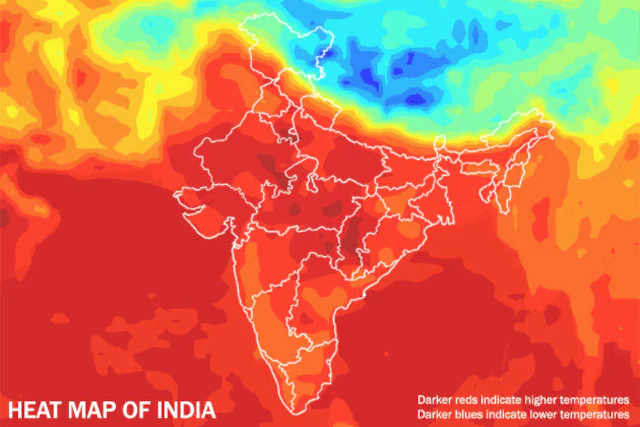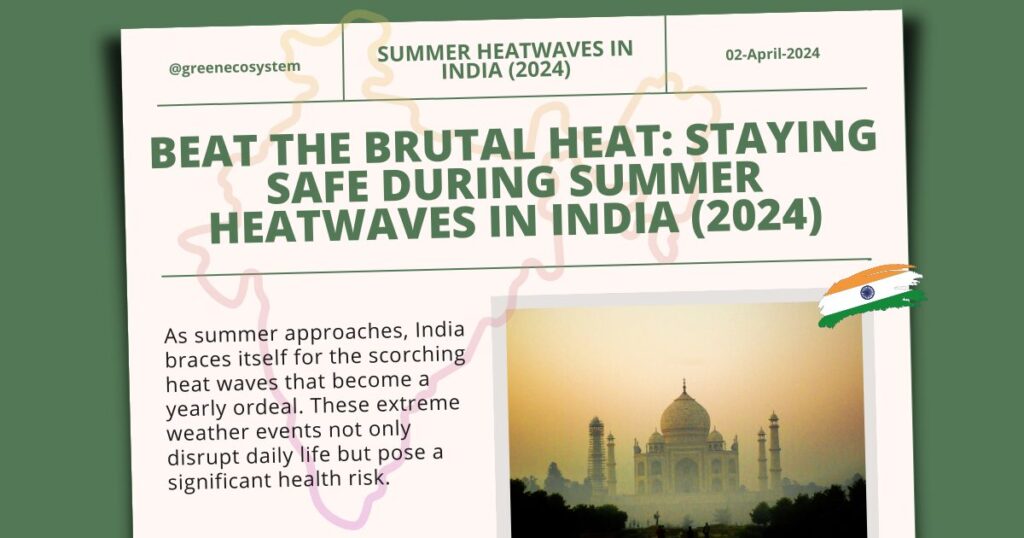As summer approaches, India braces itself for the scorching heat waves that become a yearly ordeal. These extreme weather events not only disrupt daily life but pose a significant health risk. However, with proper preparation and awareness, you can effectively navigate the heat and stay safe.
This blog explores the dangers of heatwaves, traditional and modern methods to combat them, and ways to protect your livelihood during these intense periods.
The Scorching Reality: Consequences of Heatwaves
Heatwaves are prolonged periods of exceptionally high temperatures, often accompanied by increased humidity. These conditions put immense strain on the human body, leading to several health complications:
- Heatstroke: A life-threatening condition where the body overheats and can’t regulate its temperature.
- Dehydration: Excessive sweating leads to fluid loss, causing fatigue, dizziness, and even organ failure.
- Heat exhaustion: Occurs when the body loses fluids and electrolytes, leading to weakness, nausea, and headaches.
- Aggravated pre-existing conditions: Heatwaves can worsen respiratory and cardiovascular problems.
The livelihood of many is also severely impacted by heatwaves:
- Reduced agricultural output: Extreme heat damages crops and reduces yields, impacting farmers’ income and food security.
- Labour disruptions: Outdoor work becomes incredibly difficult and unsafe, affecting productivity and daily wages.
- Increased energy demand: A surge in air conditioner usage strains the power grid, leading to potential blackouts.
Understanding the Hottest Areas in India

As summer approaches in India, so does the threat of scorching heat waves. These periods of extreme heat can be particularly brutal in certain parts of the country. Knowing if you live in a heatwave-prone region is crucial for taking the necessary precautions and staying safe.
Here’s a breakdown of the areas in India historically known for experiencing intense heat waves:
Northwestern India:
- Rajasthan: The Thar Desert, encompassing a large part of Rajasthan, is notorious for its scorching temperatures. Cities like Jaisalmer, Bikaner, and Churu frequently record highs exceeding 45°C (113°F) during peak summer months.
- Gujarat: Similarly arid, Gujarat experiences significant heatwaves, particularly in its western districts like Kutch and Saurashtra. Ahmedabad, the state’s capital, often grapples with temperatures exceeding 43°C (109°F).
- Delhi: The national capital experiences a continental climate with hot summers. While Delhi might not be the absolute hottest region, its dense population makes heat waves even more concerning.
Central India:
- Madhya Pradesh: Landlocked Madhya Pradesh experiences significant heat due to its distance from the coast. Cities like Bhopal and Jabalpur can see temperatures soar above 45°C (113°F) during heatwaves.
- Maharashtra: Parts of Maharashtra, particularly the Vidarbha region in the east, are prone to intense heat. Nagpur, often referred to as the “Tiger Capital of India,” experiences scorching summers with temperatures exceeding 42°C (108°F).
- Chhattisgarh: The eastern state of Chhattisgarh experiences hot and humid summers. Cities like Raipur and Bilaspur can see temperatures rise above 45°C (113°F) during heatwaves.
Southern India:
- Andhra Pradesh: The inland areas of Andhra Pradesh, away from the moderating influence of the coast, experience significant heat. Cities like Kurnool and Anantapur can witness temperatures exceeding 44°C (111°F) during heatwaves.
- Telangana: Landlocked Telangana experiences hot and dry summers. Hyderabad, the state capital, often grapples with temperatures exceeding 42°C (108°F) during heatwaves.
- Tamil Nadu: While coastal areas of Tamil Nadu benefit from the sea breeze, interior regions can experience significant heat. Cities like Madurai and Tiruchirappalli can see temperatures rise above 40°C (104°F) during heatwaves.
Staying Cool: Traditional and Modern Methods

Our ancestors, living without modern conveniences, developed ingenious ways to combat the heat:
- Courtyard houses: Traditional Indian architecture prioritizes open courtyards and natural ventilation for cooler living spaces.
- Earthenware pots: Storing water in earthen pots keeps it naturally cool due to the evaporative cooling effect.
- Cotton clothing: Loose-fitting, light-colored cotton garments allow for better air circulation and sweat absorption.
- Summer diet: Consumption of cooling foods like fruits with high water content (melons, cucumbers) and cooling drinks like buttermilk (lassi) helps regulate body temperature.
Modern technology offers additional options:
- Air conditioners: While effective, they contribute to increased energy consumption. Opt for energy-efficient models and use them judiciously.
- Cooling fans: Ceiling fans and portable fans circulate air, creating a wind chill effect.
- Cool roofs: Lighter-colored roofs reflect sunlight, reducing heat absorption within buildings.
Beating the Heat: Practical Steps for Everyday Life
Here’s a comprehensive plan to keep yourself safe during a heatwave:
Stay Hydrated:
- Drink plenty of water throughout the day, even if you don’t feel thirsty. Aim for 2-3 liters daily.
- Include cooling drinks like coconut water, buttermilk (lassi), and fresh fruit juices in your diet.
- Avoid sugary drinks and excessive caffeine, which can dehydrate you.
Minimize Sun Exposure:
- Limit outdoor activities during peak sun hours (11 am to 4 pm).
- Wear a hat, sunglasses, and loose-fitting, light-colored cotton clothing when going outside.
- Apply broad-spectrum sunscreen with SPF 30 or higher to protect exposed skin.
Keep Your Home Cool:
- Close curtains and blinds on sun-facing windows during the day.
- Open windows and doors at night to allow cooler air circulation.
- Utilize fans for air circulation within the house.
- If you have an air conditioner, use it wisely. Set the thermostat to a comfortable temperature (around 24-27°C) and turn it off when not in use.
Take Care of Yourself:
- Take cool showers or baths several times a day.
- Avoid strenuous physical activity during peak heat hours.
- Schedule outdoor activities for early mornings or evenings.
- Monitor yourself and others for signs of heatstroke, such as dizziness, confusion, and excessive sweating. Seek immediate medical attention if you experience any of these symptoms.
Community and Workplace Considerations:
- Check on elderly neighbours and vulnerable individuals who may be more susceptible to heatstroke.
- Employers should adjust work schedules if possible, allowing breaks in cooler areas during peak heat hours.
- Stay informed about weather forecasts and heatwave warnings issued by local authorities.
Embrace Tradition: Natural Cooling with a Timeless Touch
While modern technology offers solutions to combat the heat, India’s rich heritage provides a treasure trove of traditional practices that are not only effective but also environmentally friendly. Let’s explore some ways to revive these time-tested methods and add a touch of cultural flair to your heatwave defense strategy:
- Earthenware Magic: Earthenware pots, or “matkas” as they’re called in India, are a marvel of natural cooling. The porous clay allows for a process called evaporative cooling. As water seeps through the pot’s walls, it evaporates into the surrounding air, drawing heat away from the remaining water inside. This results in naturally cool, refreshing water perfect for beating the heat.
- Cool Comfort with Khus: Khus, a type of fragrant grass, offers a delightful and effective way to cool your living space. Khus curtains, often hung on doorways and windows, act as natural air conditioners. When moistened with water, the evaporation process creates a cool and refreshing breeze carrying the earthy scent of khus.
- Spritz and Cool Down: Traditionally, courtyards and rooftops in India were sprinkled with water during hot weather. This simple practice creates a cool and humid microclimate, offering temporary relief from the scorching heat. In a modern setting, misting fans can be used to achieve a similar effect.
- The Power of Plants: Surrounding your home with plants not only adds a touch of nature but also helps combat the heat. Plants transpire, releasing water vapor into the air, which contributes to a cooler surrounding environment. Strategically planting trees and vines around your house can provide shade and reduce heat absorption by walls.
- Cooling Cuisine: Embrace traditional summer dishes that are not only delicious but also designed to combat the heat. Dishes like buttermilk (lassi), flavored with cooling spices like cumin and coriander, and fresh fruit salads with high water content help keep you hydrated and cool from within.
Conclusion:
India’s scorching summers bring heatwaves, impacting health and livelihoods. This guide empowers you to stay safe.
Stay hydrated, minimize sun exposure, and keep your home cool. Traditional practices like using earthenware pots and cooling drinks offer sustainable solutions.
Be prepared, know your region’s heatwave risk, and embrace tradition for a safe and enjoyable summer!

